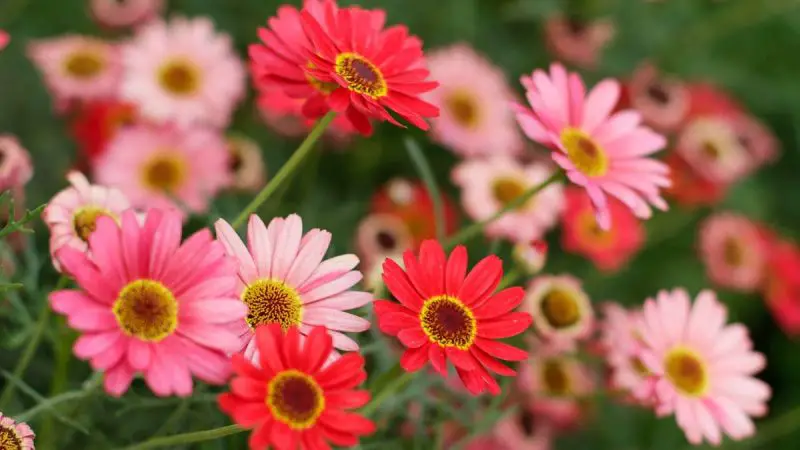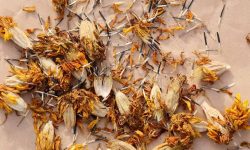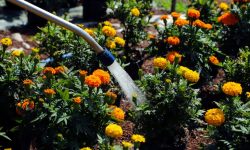Gerbera daisies are among the most striking and cheerful flowers you can grow. With their large, vibrant blooms in shades of pink, red, orange, yellow, and white, they instantly brighten gardens, patios, and indoor spaces. Their daisy-like form and long-lasting blossoms make them a favorite choice for bouquets and decorative displays. However, achieving big, healthy flowers requires more than just watering and sunlight. Gerbera daisies have specific care needs that, when met correctly, reward you with spectacular, long-lasting blooms that continue from spring into fall. Understanding their growth habits and ideal conditions is the secret to keeping them lush and radiant all season long.
Many gardeners struggle to maintain gerbera daisies after their first bloom because these plants are sensitive to overwatering, poor soil, and inconsistent light. The key to success lies in balancing sunlight, moisture, and nutrition while managing pests and promoting steady growth. Once you learn how to care for gerbera daisies the right way, they’ll flourish beautifully both indoors and outdoors. Each flower stem will grow taller, each bloom larger, and your plants will stay healthy year after year. With a few expert techniques, you can transform your garden into a dazzling display of color and life powered by these joyful, sun-loving blooms.
Understanding Gerbera Daisy Growth Habits

Gerbera daisies belong to the Asteraceae family, the same as sunflowers and zinnias, and share many of their growth characteristics. These flowering perennials are typically grown as annuals in cooler regions, but in warmer climates, they can live and bloom for several years. Their growth begins from a compact rosette of leaves at the base, from which tall, sturdy stems rise to display their large, colorful blossoms. Each flower grows on its own stem, making them perfect for cutting gardens and decorative arrangements. Understanding this structure helps gardeners know how to support healthy foliage while encouraging bigger, longer-lasting blooms.
The flowering process of gerbera daisies depends heavily on light and temperature. These plants prefer mild weather, thriving in temperatures between 60°F and 75°F (16°C–24°C). Excessive heat or cold can interrupt blooming and weaken the plant. In areas with intense summer sun, partial shade during the hottest hours of the day helps prevent leaf scorch and flower fading. On the other hand, insufficient sunlight may result in small, pale blooms or leggy growth. By providing bright, indirect light for at least six hours daily, you can ensure continuous flowering and vibrant color throughout the season.
Gerbera daisies have a moderate growth rate, with each plant capable of producing multiple blooms from early spring through late autumn. After one flower fades, another quickly takes its place, keeping the display lively for months. However, consistent maintenance—such as removing old blossoms and maintaining balanced watering—plays a major role in sustaining this growth cycle. When their needs are met, gerbera daisies become incredibly rewarding plants, offering fresh, cheerful blooms that radiate positivity in any garden or home setting.
Choosing the Right Location for Gerbera Daisies
Selecting the right location is one of the most important steps in growing big, healthy gerbera daisies. These flowers thrive in places that offer plenty of bright, indirect sunlight. Ideally, they should receive at least six hours of light each day, preferably morning sun with afternoon shade. Direct midday sunlight, especially in hot climates, can cause leaves to wilt and flowers to fade prematurely. A well-lit garden bed, balcony, or windowsill that gets gentle light exposure is perfect. When grown indoors, positioning the plant near an east- or south-facing window ensures it receives consistent brightness without overheating. Light consistency is key to producing large, colorful blooms.
Soil conditions also play a major role in determining how well your gerbera daisies grow. They prefer loose, well-draining soil rich in organic matter. Heavy clay or compacted soil retains too much moisture, which can suffocate roots and lead to root rot. A mix of garden soil, compost, and perlite or sand works best for both garden and potted plants. Proper drainage allows the roots to breathe and prevents water from stagnating. When growing in pots, always use containers with drainage holes to avoid excess moisture buildup. Healthy roots in well-aerated soil translate directly into vigorous growth and bigger flowers.
Air circulation is another important factor. Gerbera daisies dislike stagnant air, which can encourage fungal diseases and pest infestations. Space plants about 12 to 18 inches apart to allow adequate airflow around the leaves and stems. This spacing also ensures each plant receives enough sunlight. Avoid planting them near larger shrubs or dense vegetation that blocks air and light. A bright, breezy environment mimics their natural habitat, helping your gerbera daisies grow stronger, bloom longer, and stay resilient against environmental stress.
Soil Preparation and Planting Techniques for Gerbera Daisies
Preparing the Perfect Soil
Healthy gerbera daisies begin with the right soil composition. These plants thrive in loose, well-draining soil that allows air to reach their roots easily. The ideal soil mix combines equal parts of garden soil, compost, and perlite or coarse sand. This combination retains just enough moisture while preventing waterlogging. Gerbera roots are sensitive to excess moisture, so heavy clay soil should be avoided. Before planting, loosen the top 10 inches of soil and remove debris or stones that might block drainage. Mixing in organic compost improves soil texture and adds essential nutrients for early growth. The perfect soil should feel light and crumbly to the touch.
pH levels also play a vital role in how well gerberas absorb nutrients. They prefer slightly acidic soil, with a pH range between 5.5 and 6.5. Testing your soil before planting helps you make adjustments if needed. Adding a bit of peat moss can help lower pH in alkaline soils. Once the soil is well-prepared, water it lightly to settle it before placing your gerbera plants. Good soil ensures strong roots, lush foliage, and vibrant flowers that last longer throughout the growing season.
Planting Gerbera Daisies Correctly
Proper planting technique determines how well gerbera daisies establish and bloom. If planting directly in the garden, dig holes twice as wide as the root ball but not deeper. The crown—the point where the stem meets the roots—should sit just above the soil line. Planting too deep can lead to rot, while shallow planting may cause drying. When growing in containers, choose pots that are 10 to 12 inches wide with adequate drainage holes. Fill them with the prepared soil mix and plant carefully without compacting the soil too tightly.
After planting, water gently until the soil feels evenly moist. Avoid overhead watering, as wet leaves can attract fungal diseases. Instead, water at the base so moisture reaches the roots. Mulching around the plants helps retain soil moisture and regulate temperature. For best results, keep new transplants in partial shade for a few days before exposing them to full sunlight. This gradual adjustment helps prevent transplant shock. Once established, your gerbera daisies will develop deep roots and sturdy stems capable of supporting large, bright flowers throughout the growing season.
Watering and Moisture Management for Gerbera Daisies
Watering is one of the most critical aspects of gerbera daisy care, as these plants are sensitive to both drought and overwatering. They prefer evenly moist soil, but not soggy conditions. The best approach is to water deeply once or twice a week, depending on weather and soil type. Always check the top inch of soil—if it feels dry, it’s time to water. Gerbera roots need air circulation to remain healthy, so constantly wet soil can quickly lead to root rot. Early morning watering is ideal, giving plants enough moisture to endure the day’s heat while allowing leaves to dry before evening.
When watering, direct the stream toward the base of the plant rather than over the leaves. Wet foliage invites fungal diseases like powdery mildew and leaf spot. For container-grown gerberas, ensure pots have proper drainage holes, as stagnant water at the bottom can be just as harmful as underwatering. In particularly hot or dry climates, mulching around the base helps retain soil moisture and stabilizes temperature. A thin layer of organic mulch, such as straw or shredded bark, also reduces water evaporation and keeps roots cool.
Consistency is key to maintaining lush, vibrant blooms. During the growing season, monitor weather changes closely and adjust your watering routine accordingly. Too much water can lead to yellowing leaves and drooping stems, while too little can cause buds to wither before opening. Once you find the right balance, your gerbera daisies will reward you with large, radiant flowers that last for weeks. Proper moisture management doesn’t just sustain your plants—it enhances bloom size, color intensity, and overall vitality.
Light and Temperature Requirements for Gerbera Daisies
Gerbera daisies are sun-loving plants that thrive in bright, indirect light. They need at least six hours of sunlight daily to produce large, colorful blooms. Morning sun and filtered afternoon light are ideal, as harsh midday rays can scorch leaves and fade flower color. In cooler climates, full sunlight helps maximize growth and bloom production. When grown indoors, place them near an east- or south-facing window where they can receive gentle, consistent brightness. If natural light is limited, using a grow light for several hours a day can help maintain healthy growth and vibrant flower formation.
Temperature plays a vital role in the overall performance of gerbera daisies. They flourish best in mild conditions, between 60°F and 75°F (16°C–24°C). Cooler nighttime temperatures help extend bloom life and improve flower color intensity. When temperatures exceed 85°F (29°C), providing afternoon shade prevents stress and dehydration. During colder months, these flowers become dormant or stop blooming altogether. Protect them from frost, as freezing temperatures can damage roots and foliage permanently. Bringing potted plants indoors during winter ensures survival for the next growing season.
Maintaining proper air circulation and temperature balance keeps the plants healthy year-round. Avoid placing them near air conditioners, heaters, or drafty windows that cause temperature fluctuations. Consistent warmth and gentle airflow prevent disease while supporting strong, upright stems. In moderate climates, gerbera daisies bloom repeatedly throughout the year under stable light and temperature conditions. Whether indoors or outdoors, giving them balanced sunlight and warmth guarantees a steady cycle of vivid, oversized flowers that brighten every corner of your home or garden.
Fertilizing Gerbera Daisies for Bigger Blooms
Feeding gerbera daisies correctly is essential if you want to achieve large, vivid, and long-lasting flowers. These plants benefit from regular but moderate fertilization, as too many nutrients—especially nitrogen—can cause lush foliage at the expense of blooms. Start by preparing nutrient-rich soil with compost or organic matter before planting. Once the plants begin active growth, feed them every two to four weeks with a balanced, water-soluble fertilizer. A formula with equal parts nitrogen, phosphorus, and potassium, such as 10-10-10, works well. However, for bigger flowers, choose one slightly higher in phosphorus, as this nutrient supports healthy bud and bloom development.
When applying fertilizer, always water the soil lightly first to avoid root burn. Then, dilute the fertilizer to half strength for young or container-grown plants. Overfertilizing can harm roots and reduce flower quality, while underfeeding can lead to small, pale blooms. During the flowering season, maintaining a consistent feeding schedule ensures continuous bloom production. Organic alternatives like compost tea or fish emulsion also work effectively, releasing nutrients gradually while improving soil health. This natural approach keeps the ecosystem balanced and reduces the risk of chemical buildup that might hinder growth.
It’s equally important to adjust your feeding routine based on seasonal conditions. In cooler months, reduce fertilization since plant activity slows, and excess nutrients can accumulate in the soil. During peak blooming months, more frequent but diluted feeding enhances petal size and color intensity. Always watch your plants closely—deep green leaves and strong stems are signs of proper nutrition. When gerbera daisies receive balanced feeding, they respond with larger, brighter, and more resilient flowers that transform any garden into a vivid masterpiece.
Pruning and Deadheading Techniques for Continuous Flowering
Pruning and deadheading are key practices that keep gerbera daisies blooming continuously and looking their best. These techniques help the plant conserve energy by directing nutrients toward new flower growth instead of old, fading blooms. Deadheading should begin as soon as the first blossoms start to wilt. Gently remove spent flowers by cutting the entire stem down to the base rather than just plucking off the head. This prevents the plant from wasting energy on seed production and encourages fresh blooms to emerge. Regular deadheading also improves air circulation, reducing the risk of fungal infections that often develop on decaying petals.
Light pruning helps maintain compact, healthy growth. Over time, gerbera daisies can produce excess foliage that shades inner leaves and buds, slowing bloom production. Trimming older or damaged leaves every few weeks revitalizes the plant and allows more sunlight to reach the center. Use clean, sharp scissors or pruning shears to avoid tearing the delicate stems. Always sterilize your tools between cuts to prevent the spread of disease. For potted plants, pruning back overcrowded leaves helps balance size and promotes stronger root systems that support bigger flowers.
Seasonal pruning ensures long-term vigor. In late fall, after the final blooms fade, trim the plant lightly to remove old growth and prepare it for dormancy. For perennial varieties grown in warmer climates, deeper pruning in early spring stimulates new shoots and stronger flowering stems. Removing dead or weak parts keeps the plant active and prevents nutrient waste. With consistent pruning and deadheading, your gerbera daisies will maintain a steady rhythm of lush green foliage and brilliant blossoms that brighten your space all year long.
Common Problems When Growing Gerbera Daisies
Overwatering and Root Rot
One of the most common issues with gerbera daisies is overwatering, which often leads to root rot. These plants prefer moist but well-drained soil and struggle in standing water. When the roots remain submerged, they suffocate, turning soft and brown, eventually killing the plant. The first signs of overwatering are yellowing leaves, drooping stems, and a foul smell near the soil surface. Many gardeners mistake these symptoms for drought stress and add more water, worsening the problem. To prevent this, always check soil moisture before watering. The top inch should feel dry before adding more.
If root rot develops, remove the plant from the pot or garden bed and inspect the roots. Trim away any dark, mushy sections, then repot the plant in fresh, sterile soil with good drainage. Adding perlite or coarse sand improves airflow around the roots. When watering, aim for consistency—deep but infrequent watering is best. Also, avoid using saucers that hold excess water under pots. Once proper drainage and watering habits are established, gerbera daisies recover quickly, producing strong new roots and fresh blooms.
Pest and Disease Issues
Gerbera daisies, though hardy, can attract pests and diseases that hinder growth and flowering. Aphids, spider mites, and whiteflies are the most common insect invaders, feeding on plant sap and causing curling leaves or discolored patches. Regularly inspecting the undersides of leaves helps catch infestations early. Spraying the plants with a mix of mild soap and water or applying neem oil keeps pests under control without harming beneficial insects. Good air circulation and balanced moisture also deter pest buildup.
Fungal problems like powdery mildew and leaf spot appear when humidity is high or leaves stay wet for too long. To prevent them, water at the base of the plant instead of from above, and space your gerberas adequately to allow airflow. If infection occurs, remove the affected leaves and apply a gentle fungicide. Maintaining clean tools and healthy soil reduces disease recurrence. When managed properly, pests and fungi rarely become serious threats. Consistent monitoring and quick action keep your gerbera daisies vigorous, resilient, and blooming beautifully season after season.
Seasonal Care Tips for Gerbera Daisies
Spring Care
Spring is the most important season for establishing healthy gerbera daisies. As temperatures warm, inspect overwintered plants or prepare new ones for planting. Loosen the soil, remove weeds, and mix in compost to boost nutrients. Spring planting ensures that the roots establish before summer heat sets in. When starting new plants, keep them in partial shade for a few days to help them adjust to sunlight and prevent transplant shock. Once settled, move them into full or bright indirect sun for at least six hours daily.
During this stage, water regularly but avoid oversaturation, as young roots are delicate. Light feeding with a balanced fertilizer every two weeks helps encourage foliage and bud development. Watch for pests such as aphids that are drawn to tender new growth. Removing them early keeps the plants strong. Proper spacing between each plant ensures airflow, which prevents disease and encourages faster growth. By the end of spring, gerbera daisies will have formed a solid root system and begun to produce the first flush of colorful blooms that signal a healthy, thriving growing season ahead.
Summer Care
Summer brings the most spectacular blooming period for gerbera daisies, but it also challenges gardeners with heat and dryness. These plants love sunlight but can suffer under extreme temperatures. Water deeply two to three times a week in the morning so the roots can absorb moisture before midday heat. Avoid wetting the leaves to prevent fungal problems. Adding a layer of mulch around the base of the plants helps retain soil moisture, cool the roots, and minimize evaporation. Consistent watering keeps flowers large, bright, and long-lasting even during hot days.
Feeding every three to four weeks with a phosphorus-rich fertilizer enhances flowering. Remove faded or wilting flowers regularly to redirect the plant’s energy toward producing new blooms. In regions with intense summer heat, providing partial afternoon shade can prevent leaf burn and fading. Check frequently for pests like spider mites or thrips, which thrive in hot, dry air. Gentle misting helps maintain humidity and discourages infestations. With steady watering, light feeding, and sun protection, your gerbera daisies will flourish all summer, filling your garden with radiant color and continuous blooms.
Fall Care
As autumn arrives, gerbera daisies start transitioning from active flowering to storing energy for the next cycle. The cooler air extends bloom life, but shorter days gradually slow growth. Water moderately to keep the soil moist but not soggy, and stop fertilizing by mid-fall. Removing faded flowers and trimming older leaves helps the plant focus on root strength rather than top growth. This maintenance also improves airflow and reduces disease risk in the cooler, damper air of fall.
If frost threatens, prepare early. Potted gerberas should be brought indoors or into a greenhouse before nighttime temperatures drop below 50°F (10°C). For garden-grown plants in mild regions, cover the base with mulch to protect roots from temperature swings. Harvest mature seed heads now if you wish to propagate new plants next season. Seeds should be dried thoroughly and stored in paper envelopes in a cool, dark place. By maintaining gentle watering, light pruning, and root protection, your gerbera daisies will remain strong and ready for a vigorous return when spring warmth returns.
Winter Care
Winter is the resting phase for gerbera daisies, a time to protect and preserve their energy for future growth. In most regions, these flowers cannot survive freezing temperatures outdoors. After the first frost, cut back the plants to about two inches above the soil and cover with a thick layer of mulch or straw to insulate the roots. In areas with heavy snow or hard freezes, dig up the plants and transfer them into pots for indoor overwintering. Keep them in a cool, dry room with temperatures between 45°F and 55°F (7°C–13°C).
For indoor gerberas, place pots near bright windows but away from cold drafts and heating vents. Water sparingly—just enough to keep the soil from drying completely. Overwatering during dormancy can cause root decay. Do not fertilize until new growth appears in spring. Occasionally check for yellowing or damaged leaves and remove them promptly to prevent fungal spread. Winter care is all about maintenance, not growth. With proper shelter, controlled watering, and a little patience, your gerbera daisies will survive the cold months and burst back to life with bigger, brighter blooms when the warmth of spring returns.
FAQs About Caring for Gerbera Daisies
How often should I water gerbera daisies?
Water gerbera daisies when the top inch of soil feels dry. Deep watering two to three times a week is usually enough. Avoid overwatering, as soggy soil causes root rot. Morning watering is best—it allows the plant to absorb moisture and dry before evening, preventing fungal issues.
Why are my gerbera daisy leaves turning yellow?
Yellow leaves often indicate overwatering or poor drainage. Ensure the soil dries slightly between watering sessions and check that containers have drainage holes. Too little sunlight or low nitrogen can also cause yellowing, so adjust your watering schedule and provide sufficient bright, indirect light.
Can gerbera daisies grow indoors?
Yes, gerbera daisies grow beautifully indoors when given enough light. Place them near an east or south-facing window with at least six hours of sun daily. Keep the soil moist but not soggy, and maintain temperatures between 65°F and 75°F for continuous growth and vibrant blooms.
How do I make my gerbera daisies bloom more?
Encourage more blooms by deadheading faded flowers, providing full sunlight, and using a fertilizer higher in phosphorus. Avoid excessive nitrogen, as it produces leaves instead of flowers. Consistent watering and pruning old foliage help redirect energy toward larger, longer-lasting blossoms throughout the season.
Do gerbera daisies come back every year?
In warm climates, gerbera daisies can act as short-lived perennials, returning each spring. In colder areas, they’re typically grown as annuals but may self-seed. You can overwinter potted plants indoors by protecting them from frost and reducing watering until new growth appears in spring.
Conclusion
Caring for gerbera daisies the right way transforms these charming flowers into radiant garden showpieces. With balanced watering, rich but well-draining soil, and plenty of sunlight, each plant rewards your effort with larger, brighter blooms. Proper pruning, feeding, and seasonal attention keep them strong and blooming continuously. Whether grown indoors or outdoors, gerbera daisies thrive when given consistency, patience, and care. Their vivid colors and joyful presence uplift any space, symbolizing warmth and happiness. By mastering their care, you’ll enjoy not only a garden full of color but also the satisfaction of nurturing beauty that lasts season after season.






